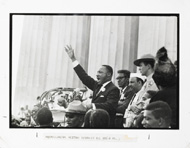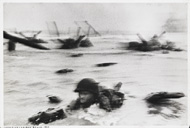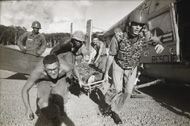 |

 |
 |
Martin Luther King Jr., Washington, D.C., Bob Adelman, 1963
Permission granted by Intellectual Properties Management, Atlanta, Georgia, as manager of the King Estate.
© Bob Adelman/Magnum Photos
|
 |
This exhibition of press photographs from the Getty Museum's collection focuses on coverage of selected world events between 1944 and the mid-1970s, the heyday of wirephoto (pre-digital) technology. In 1935 the Associated Press (AP) launched its wirephoto network. The news system, and others that followed, allowed news images to be delivered quickly over telephone lines, and therefore to be published around the world with greater ease than ever before. By 1940, photographs occupied roughly one-third of news space in the average U.S. metropolitan newspaper, attaining a prominence in the relating of events that still exists today. In the image above, Bob Adelman captured the climax of Dr. Martin Luther King's "I Have a Dream" speech at the Lincoln Memorial during the March on Washington demonstration in 1963.
|
 |

 |
 |
Omaha Beach, Normandy, France, Robert Capa, negative, June 6, 1944; print, about 1964
© Cornell Capa / Magnum Photos
|
 |
 |
Robert Capa built his reputation as a war photographer. Among his most iconic images are those he captured during the D-Day invasion of France's Normandy coast in World War II. As a war correspondent for Life magazine, he accompanied the first wave of American troops onto Omaha Beach.
For Capa, immediacy took precedence over image legibility in his coverage of battle. In this image that reflects the soldier's point of view, blurred forms, harsh contrasts, and grainy quality—all results of the conditions under which the picture was made—add credibility to the photograph as a record of visceral experience. The image gives a vicarious sense of the chaos, turbulent motion, and adrenaline that must have accompanied the assault.
|
 |
 |

 |
 |
Vietnam, Larry Burrows, July 12, 1966
© Larry Burrows Collection
|
 |
Larry Burrows, who photographed for Life magazine during the Vietnam War, carried Capa's tradition into the 1960s. Though he is best known for his work with color materials, he was prolific in black-and-white photography. Related groups of his pictures were often published across several page spreads, providing a visual parallel to textual accounts of the war. The magazine's predilection for positive images of the war may have influenced Burrows's approach, which often gave preference to heroic rather than horrific presentations of the conflict.
Helicopters were a critical means of transportation and of waging war in the Vietnam conflict. Larry Burrows covered this aspect of military operations in great detail for Life, accompanying soldiers on airlifts into the jungle and documenting evacuations of the wounded.
|
 |

 |
 |
John F. Kennedy, Burbank, California, Robert Flora, September 9, 1960
Copyright permission courtesy of Corbis-Bettmann
|
 |
 |
Seemingly banal events, like arriving at an airport, can become newsworthy moments when politics and celebrity are involved. This picture, made by the Los Angeles-based photographer Robert Flora, shows Senator John F. Kennedy arriving in California less than two months after being confirmed as the Democratic nominee for President in 1960. Kennedy and his family were the subjects of great fascination among the American public, and images of them featured prominently and frequently in magazines and newspapers around the nation in the 1950s and early 1960s.
This press print, with Flora's own typed caption affixed, was used to transmit the image and its description over phone lines for possible use by newspapers around the nation.
|
 |
 |

 |
 |
Atomic Explosion, Bikini Atoll (verso), July 25, 1946
|
 |
Used to reproduce images in newspapers and magazines, many of the prints in the exhibition show the stamps, inscriptions, airbrushing, and worn quality of frequently handled archival documents.
Press prints of important events typically find their way into the media repeatedly, often over the course of many years. Whenever one is reproduced, its reverse side (called the "verso") is date stamped by the publication. Sometimes descriptive captions are added. This is the verso of a press print used by the New York Times to reproduce an image of the Baker Day atomic test at the Bikini Atoll in 1946.
  See the image on the front of the photograph. See the image on the front of the photograph.
|
 |
|
This exhibition is located at the Getty Center, Museum, West Pavilion.
|
 |